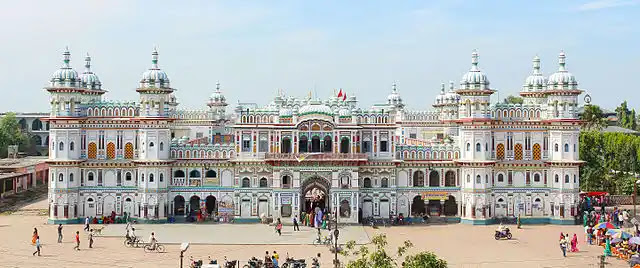Facts About Janaki Temple: The Janaki Temple, also known as Sita Mata Temple, is a Hindu temple located in Janakpur, Nepal and is dedicated to the Hindu goddess Sita. This temple holds great religious and cultural significance for Hindus all over the world, and is considered one of the most important pilgrimage sites for devotees of the Ramayana epic. In this article, we will explore the history, significance, architecture, festivals, and other aspects of the Janaki Temple in-depth.
Discovering the Rich Heritage of Janaki Temple: 10 Fascinating Facts
- Historical background: The Janaki Temple is said to be built on the spot where Sita, the wife of Lord Rama, was born and raised. According to Hindu mythology, Sita was the daughter of King Janaka of Mithila and was considered an incarnation of the Hindu goddess Lakshmi. The temple is considered one of the most important religious sites in Nepal and attracts millions of devotees from around the world every year.
- Religious significance: The Janaki Temple is considered a sacred site for Hindus and holds great religious significance for those who follow the Ramayana epic. The temple is believed to be the birthplace of Sita and is considered a symbol of the devotion and love between Lord Rama and Sita. The temple is also considered a representation of the Hindu belief in the sanctity of marriage and the power of love.
- Architectural style: The Janaki Temple is built in a traditional Nepalese architectural style and features intricate carvings and embellishments. The entrance to the temple is adorned with carvings of Lord Rama, Sita, and Lakshmana, and the temple complex includes several smaller shrines, each dedicated to different Hindu gods and goddesses. The temple is a beautiful example of traditional Nepalese architecture and serves as a symbol of Nepalese cultural heritage.
- Festival celebrations: The Janaki Temple is a site of several annual festivals and ceremonies, including the Navaratri Festival, Ram Navami, and Sita Vivah Utsav. During these festivals, the temple is decorated with lights and flowers, and devotees gather to perform puja and sing devotional songs. These festivals are an important cultural and religious event in Nepal and bring together people from all over the world to celebrate their shared love for Sita and Lord Rama.
- Religious artifacts: The Janaki Temple houses several religious artifacts, including a sacred lamp, a bell, and a statue of Sita. The statue is made of silver and is considered one of the most important religious artifacts in the temple. The sacred lamp and the bell are also important religious artifacts and are used in various religious ceremonies and rituals.
- Religious text references: The Janaki Temple is mentioned in several ancient Hindu religious texts, including the Ramayana and the Puranas. These texts describe the birthplace of Sita and the importance of Janakpur as a sacred site for Hindus. The temple is also referred to as Janakpur, the city of Janaka, who was the father of Sita and the king of Mithila.
- Cultural significance: The Janaki Temple is not only a religious site but also a cultural hub. The temple serves as a symbol of Nepalese cultural heritage and is an important tourist attraction in Nepal. Visitors to the temple can learn about the rich cultural heritage of Nepal and experience the unique architecture and carvings of the temple complex.
- Tourist attraction: In addition to its religious significance, the Janaki Temple attracts tourists from all over the world due to its beautiful architecture and rich cultural heritage. Visitors to the temple can explore the complex, admire the carvings, and learn about the history and significance of the site. The temple is also a popular destination for Hindu pilgrims, who come to pay their respects to Sita and Lord Rama and seek blessings.
- Community involvement: The Janaki Temple is not only a religious site, but it also serves as a center of the community. The temple serves as a gathering place for devotees and is a source of support and comfort for those in need. The temple complex includes several smaller shrines and temples, and the community comes together to participate in various religious ceremonies and festivals.
- Conservation efforts: In recent years, there have been efforts to preserve and conserve the Janaki Temple and its complex. The Nepalese government and local communities have been working together to preserve the temple's cultural and religious heritage and maintain the beauty and integrity of the site. This has included the restoration of the temple and its surrounding structures, the installation of modern amenities and facilities, and the promotion of the temple as a tourist attraction.
In conclusion, the Janaki Temple is a beautiful and historic temple that holds great religious and cultural significance for Hindus all over the world. The temple is a symbol of the devotion and love between Lord Rama and Sita and serves as a source of inspiration and comfort for devotees. With its rich history, beautiful architecture, and religious significance, the Janaki Temple is a must-visit destination for those interested in Hindu religion and Nepalese culture.














0 Comments